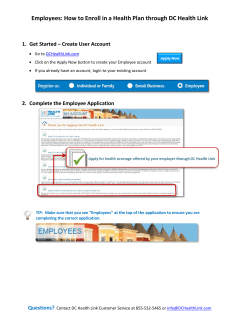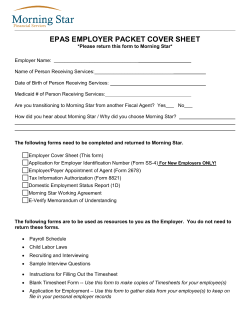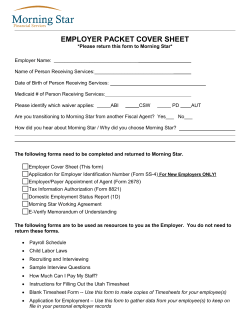
RICS Singapore Branch An Overview of the FIDIC FORMS OF CONTRACT
RICS Singapore Branch CPD Event 19 June 2012 An Overview of the FIDIC FORMS OF CONTRACT and Contracts Committee Activities Philip Jenkinson Chair of the FIDIC Contracts Committee Principal Consultant ATKINS 1 Objectives • • • • • Educational and informative Identify and prioritise industry issues Assess barriers, opportunities and risks Identify potential actions (by FIDIC/CC) Identify milestones, success factors and how to assess or measure progress 2 Consultancy Agreements • Client/Consultant Model Services Agreement, Fourth Edition 2006 • Sub-Consultancy Agreement, First Edition 1992 • Joint Venture Agreement, First Edition 1992 • Model Representative Agreement, Test Edition 2004 3 The Traditional FIDIC Forms of Contract • Conditions of Contract for Works of Civil Engineering Construction (Red Book) Fourth Edition 1987 • Conditions of Contract for Electrical and Mechanical Works including Erection on Site (Yellow Book) Third Edition 1987 4 Basics • Between Employer and Contractor • Red Book: payment monthly for work done • Yellow Book: lump sum on milestones • • • • Every project is unique Guidelines of ’best practice’ Part I – General Conditions Part II – Conditions of Particular Application 5 Fair and balanced approach • Risk is allocated to the party that is best able to bear and control that risk • Compensation and time extension allowed when uncalculated hindrances occur • ‘Engineer’ whose job is principally to supervise and monitor the work – in strict accordance with the Contract to the satisfaction of the Engineer – with formal ‘Engineer’s Decision’ 6 The Orange Book • Conditions of Contract for Design-Build and Turnkey (Orange Book) First Edition 1995 • Employer’s Representative – not required to be impartial – determine matters fairly, reasonably and in accordance with the Contract • Independent dispute adjudication board • 1996/7 Supplements for use of DAB (R/Y Books) 7 The 1999 Suite of Standard Conditions of Contract • Conditions of Contract for Construction - design by Employer: The Construction Contract (The New Red Book) • Conditions of Contract for Plant and Design-Build - design by Contractor: The Plant and Design/Build Contract (The New Yellow Book) • Conditions of Contract for EPC Turnkey Projects: The EPC/Turnkey Contract (The Silver Book) • Short Form of Contract: The Short Form (The Green Book) • The FIDIC Contracts Guide (2000) 8 Principles behind the 1999 Books • More consistent wording, with improved clarity; user-friendly format and layout • Balance between legal precision and practicability; compatible with both common and civil law concepts • ‘Manuals of good engineering practice’ • Prepared by engineers for practical use 9 Principles (continued) • Traditional role of ‘the Engineer’ to make impartial determinations modified to reflect current practice (Red and Yellow Books) • ‘Employer’s Representative’ introduced: must be fair and reasonable (Silver and Green Books) 10 Principles (continued) • Distinction between the Books is based on: – who does the design? – who bears the risk for change in quantities? • EPC (Silver Book) provides for the Contractor taking almost all risks (new for FIDIC) • Short Form (Green Book) deals with the wide demand for a simpler form of 11 contract Principles (continued) • Work must continue, regardless of differences: amicable settlement encouraged • Strong financial management: detailed claims procedures must be followed 12 General Remarks on the 1999 Books • Suitable for both ‘international’ and domestic use • A framework adaptable to suit local law • More definitions: harmonised, except for the Short Form 13 General Remarks (continued) • General Conditions not applicable can be disregarded • Example Particular Conditions are given • Adjudication precedes arbitration 14 The 1999 Red and Yellow Books • Emphasis changed to party responsible for design • 1999 Yellow Book replaced both 1987 Yellow Book and Orange Book • Traditional competitive tendering procedures • Risk sharing is balanced • All claims, from either Party, have to follow a strict procedure • Engineer is no longer stated to be ‘impartial’: he ‘shall be deemed to act for the Employer’, except when fair determinations are required 15 The 1999 Red Book • For building and engineering works designed by the Employer • Needs of modern multi-discipline contracts recognised • Partial Contractor design possible • Valuation and payment based on remeasurement of quantities, but lump sum or cost plus could be used 16 1999 Red Book (continued) • No ‘Clause 67’ Engineer’s decision • If a dispute arises, reference to DAB • Dispute resolution procedure is: adjudication (DAB)>>>amicable settlement >>>arbitration 17 The 1999 Yellow Book • For E&M plant, and for building and engineering works, designed by the Contractor • Needs of modern multi-discipline contracts recognised • Partial Employer design: include in Employer’s Requirements 18 1999 Yellow Book (continued) • Valuation and payment based on lump sum with payment plan, but remeasurement possible • No ‘Clause 67’ Engineer’s decision • If a dispute arises, reference to DAB • Dispute resolution procedure is: adjudication (DAB)>>>amicable settlement >>>arbitration 19 The Silver Book (EPCT Contract) • More certain final price and time required - balance of risk being changed - privately financed BOT type • Contractor asked to cover extra risks • Employer will have to pay more • Completely new Book - ‘unbalanced’ risk • BUT full open acceptance of risk picture • Starting point for BOT type projects 20 The Silver Book (continued) • The EPCT Contract is suitable for: particularly E&M and process plant projects all types of Employers civil law jurisdictions where government employer or private developer wants a fixed price turnkey basis and two-party approach • There is an ‘Introductory Note’ of explanation 21 Special Features of the Silver Book • Responsibility for design lies with Contractor • Employer’s Requirements usually a ‘performance specification’ (functional basis) • Contractor carries out all engineering, procurement, construction, ready for operation at the ‘turn of a key’ • No Engineer - instead the Employer • Lump Sum Contract Price (but adjustments in limited specified cases) 22 Special Features (continued) • Testing procedures to demonstrate achievement of specified end result • Contractor carries majority of risks, so Employer pays more • Final price and time should be more certain • Small number of tenderers with negotiation • Contractor given freedom to use own methods • Has to prove reliability and performance 23 Special Features (continued) • These Conditions are not suitable in the following circumstances: if time or information is insufficient before Contract signature if considerable work underground or difficult to inspect if Employer intends to supervise closely or control or review if an intermediary certifies interim payments where part of the Works is designed by Employer for public bidding without negotiations • For such circumstances P&DB should be used instead 24 The Green Book (Short Form of Contract) • • • • • • US$ 500,000 and six months’ duration Simple and repetitive works All provisions necessary in 15 clauses Language uncomplicated and simple Balanced risk sharing - no Engineer Design by either party - all types of construction • Payment on lump sum or any other basis 25 Dredging and Reclamation • Design by Employer or Contractor • Valuation – all main methods available • Engineer required to act “fairly” in accordance with Contract • No defects liability on dredging • Special insurance provisions • Adjudication by DAB, then arbitration 26 Red Book MDB Harmonised Version • Based on 1999 Red Book • Incorporates main common changes normally required by MDBs, e.g.- audits, labour provisions, corruption avoidance, dispute settlement • Use subject to Licence Agreement between FIDIC and participating banks 27 Design, Build and Operate Projects • Conditions of Contract for Design, Build and Operate Projects (Gold Book), First Edition 2008 • Assumes ~20-year operation period • Modern approach to risk and insurance • Employer’s Representative • Adjudication by DAB, then arbitration 28 Subcontracts • Conditions of Subcontract for Construction, Test Edition 2009 • Intended for use with 1999 Red Book • General Conditions – Particular Conditions • Annexes require provision of relevant information 29 Protection of the Environment • The Contractor shall take all reasonable steps to protect the environment (both on and off the Site) and to limit damage and nuisance to people and property resulting from pollution, noise and other results of his operations 30 Environment (continued) • The Contractor shall ensure that emissions, surface discharge and effluent from the Contractor’s activities shall not exceed the values indicated in the Specification, and shall not exceed the values prescribed by applicable Laws 31 Project Phases • • • • • • Initiation Study and Evaluation Design Development Detailed Design Contracts Construction, Manufacture, Shipping, Installation, Testing and Commissioning • Operations and Maintenance 32 Initiation • The Concept • The Big Decisions • Policy • Major Choices 33 Study and Evaluation • Feasibility • Alternatives • Strategy • Statutory Requirements 34 Design Development/ Detailed Design • Specifications • Special Requirements • Approvals • Inclusion of results/outcomes from earlier Project Phases 35 Contracts Committee • Mandate from Executive Committee • Members: Christoph Theune/ Zoltán Záhonyi/Philip Jenkinson • Special Advisers: Nael Bunni/ Axel Jaeger/ Michael Mortimer-Hawkins/ Chris Seppala/ Chris Wade • Task Group Leaders and Members 36 Contracts Committee Terms of Reference • To recommend to the Executive Committee which Conditions of Contract and related documents should be prepared or updated by FIDIC • To assist the Secretariat in establishing Task Groups as required, to monitor their work at agreed intervals and to carry out a final review of the documents for submission to the Executive Committee • To assist the Secretariat in handling queries on the interpretation of documents • To liaise, in conjunction with the Secretariat, with organisations interested in the FIDIC Conditions of Contract • To suggest topics and speakers as appropriate for seminars and workshops 37 Current Workload • • • • • • • • • • • TG1 – DBO Form of Contract TG2 – Procurement Procedures Guide TG4 – Consultancy Agreements TG5 – Subcontract Form (Red Book) TG6 – Update of 1999 Suite (Yellow Book first) TG7 – Update of Dredging Contract (with IADC) TG8 – Update of Short Form (Green Book) TG9 – YB/SB Subcontract Forms TG10 – Tunnelling (proposed, with ITA) TG11 – ODB Form of Contract Training Courses 38
© Copyright 2025





















